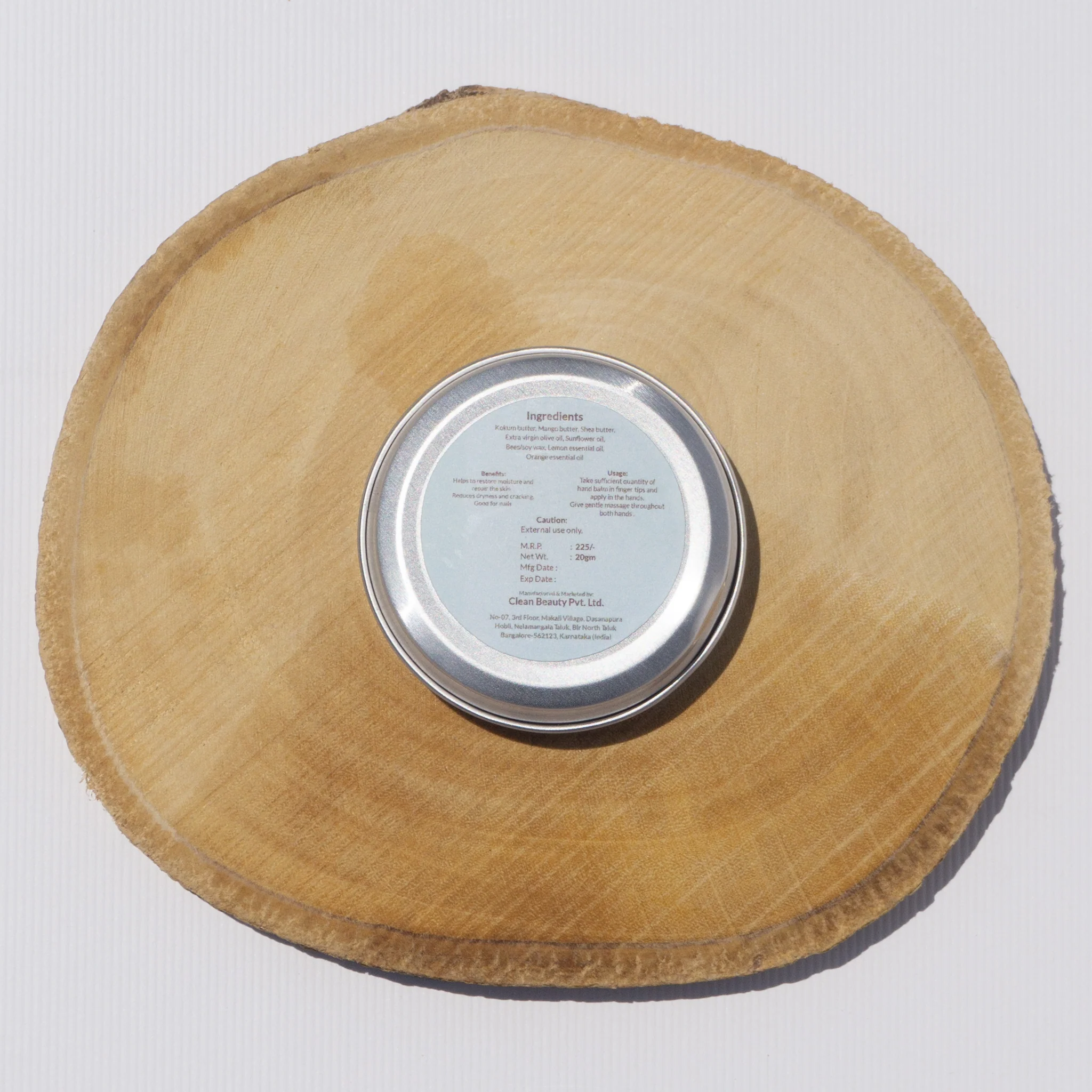Natural Body Care, Natural Body Lotions
Hand Balm
₹225.0
Benefits
Helps to restore moisture and repair the skin Reduces dryness and cracking
Good for nails
- Description
- Additional information
- Reviews (0)
- Q & A
- Sustainability Remark
- More Offers
- Store Policies
- Inquiries
Ingredients
Kokum butter
Mango butter
Shea butter
Extra virgin olive oil
Sunflower oil
Bees/soy wax
Lemon essential oil
Orange essential oil
Benefits
Helps to restore moisture and repair the skin Reduces dryness and cracking
Good for nails
Usage
Take a sufficient quantity of hand balm in fingertips and apply to the hands.
Give a gentle massage throughout both hands
Caution
External use only
| Weight | 0.02 kg |
|---|
You must be logged in to post a review.
Q & A
There are no questions yet
1. Choice of Ingredients
Many sustainable hand balms use natural, organic, and locally sourced ingredients. These ingredients often require less energy to produce and process compared to synthetic alternatives.- Natural and Organic Ingredients: These often have a lower environmental impact because they are grown without synthetic pesticides and fertilizers, which are energy-intensive to produce.
- Locally Sourced Ingredients: Sourcing ingredients locally reduces transportation emissions, which is a significant contributor to the carbon footprint of products .
2. Production Processes
Sustainable hand balm production involves eco-friendly manufacturing practices that minimize energy use and waste.- Energy-Efficient Manufacturing: Using renewable energy sources (e.g., solar, wind) in the manufacturing process can significantly reduce the carbon footprint.
- Minimal Processing: Less processing means lower energy consumption. For instance, cold-pressed oils and butters require less energy to produce compared to refined oils.
3. Packaging
Sustainable hand balms often use eco-friendly packaging, which can reduce their overall environmental impact.- Recyclable and Biodegradable Packaging: Using materials like glass, aluminum, or biodegradable plastics reduces waste and the carbon footprint associated with disposal .
- Minimal Packaging: Reducing the amount of packaging material not only conserves resources but also lowers emissions from production and transportation.
4. Distribution
Efficient distribution strategies can help lower the carbon footprint of hand balms.- Optimized Logistics: Efficient transportation routes and methods (e.g., bulk shipping, electric vehicles) can reduce greenhouse gas emissions.
- Local Distribution: Selling products locally or regionally reduces the distance they need to travel, thus lowering transportation-related emissions.
Scientific Explanation and References
Carbon Footprint Reduction Strategies:
- Life Cycle Assessment (LCA): This methodology assesses the environmental impacts of a product from raw material extraction through production, use, and disposal. Sustainable hand balms often show lower environmental impacts in LCA studies due to their eco-friendly ingredients and processes .
- Sustainable Agriculture: Using sustainably grown crops for ingredients can reduce emissions related to fertilizer use, soil degradation, and water consumption .
- Renewable Energy: Utilizing renewable energy in manufacturing reduces reliance on fossil fuels, lowering the carbon footprint significantly .
Conclusion
The sustainability and low carbon footprint of hand balm products are achieved through the use of natural, organic, and locally sourced ingredients, energy-efficient production processes, eco-friendly packaging, and optimized distribution methods. These strategies are supported by scientific studies and life cycle assessments that highlight the environmental benefits of such practices.References:
- EPD International. "Environmental Product Declarations (EPD)." EPD International AB, 2021.
- Notarnicola, B., Sala, S., & Anton, A. "Life Cycle Assessment in the Agri-food Sector." Springer, 2020.
- Al-Salem, S. M., Lettieri, P., & Baeyens, J. "Recycling and Recovery Routes of Plastic Solid Waste (PSW)." Waste Management, 2009.
- European Bioplastics. "Biodegradable and Compostable Packaging." European Bioplastics e.V., 2021.
- Roy, P., Nei, D., Orikasa, T., Xu, Q., Okadome, H., Nakamura, N., & Shiina, T. "A Review of Life Cycle Assessment (LCA) on Some Food Products." Journal of Food Engineering, 2009.
- Tilman, D., Cassman, K. G., Matson, P. A., Naylor, R., & Polasky, S. "Agricultural Sustainability and Intensive Production Practices." Nature, 2002.
- REN21. "Renewables 2021 Global Status Report." REN21 Secretariat, 2021.
No more offers for this product!
General Inquiries
There are no inquiries yet.



















Reviews
There are no reviews yet.